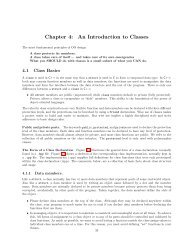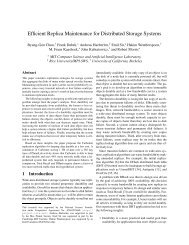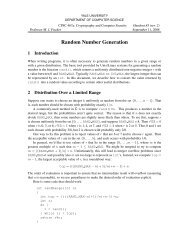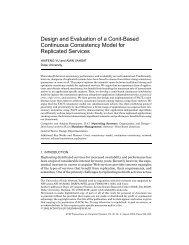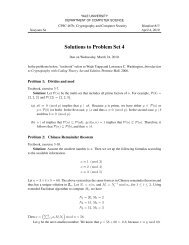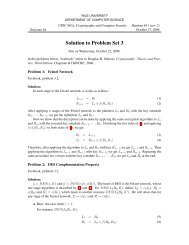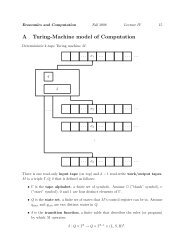Unreliable Failure Detectors for Reliable Distributed Systems
Unreliable Failure Detectors for Reliable Distributed Systems
Unreliable Failure Detectors for Reliable Distributed Systems
Create successful ePaper yourself
Turn your PDF publications into a flip-book with our unique Google optimized e-Paper software.
256 T. D, CHANDRAAND S. TOUEGEvery process p executes the foJJowingoutputp t 0<strong>for</strong>atlq EfI {AP(q) denotes the duration of p‘s time-out interuai <strong>for</strong> q}AP(q) t default time-out intervalcobeginII Task 1: repeat periodicallyaend “p-is-alive” to allII Task 2: repeat periodically<strong>for</strong> all g C f’fif q $! Outputp andp did not receive “q-is-aJive” during the last AP(9) ticks of p’s clockOutputp t Outputp u {q} {p times-out on q: it now suspects q has cmshd}II Tad 3: when receive “q-is-alive” <strong>for</strong> some qif q E Outputp {p knows that it prematurel~ timed-out on q}ou~Pu~p- ou~Pu~p- {q} {1. p repents on q, and}AP(q) t AP(g) + I {2. p incrwwes its time-out period <strong>for</strong> q)coendFIG. 10. A time-out based implementation of ‘2bE 09 in models of partial synchrony.considered, Dolev et al. [1987] delineate precisely the boundary between solvabilityand unsolvability of Consensus, and provides an answer to the question“What is the least amount of synchrony sufficient to solve Consensus?”.Dwork et al. [1988] consider two models of partial synchrony. Roughlyspeaking, the first model (denoted .& here) stipulates that in every executionthere are bounds on relative process speeds and on message transmission times,but these bounds are not known. In the second model (denoted .&) these boundsare known, but they hold only after some unknown time (called GST <strong>for</strong> Globs/Stabilization Time). In each one of these two models (with crash failures), it iseasy to implement an Eventually Perfect failure detector ~ E Of??.In fact, we canimplement such a failure detector in a weaker model of partial synchrony(denoted .M3): one in which bounds exist but they are not known and they holdonly after some unknown time GST. 24 Since OQ?’> OW, by Corollaries 6,2.4 and7.1.8, this implementation immediately gives Consensus and Atomic Broadcastsolutions <strong>for</strong> J4&and, a <strong>for</strong>tiori, <strong>for</strong> Ml and d.42.The implementation of $3 ~ W <strong>for</strong> .M3,which uses an idea found in Dwork etal. [1988], works as follows (see Figure 10). To measure elapsed time, eachprocess p maintains a local clock, say by counting the number of steps that ittakes. Each process p periodically sends a “p-is-alive” message to all theprocesses. If p does not receive a “q-is-alive” message from some process q <strong>for</strong>AP(q) time units on its clock, p adds q to its list of suspects. If p receives“q-is-alive” from some process q that it currently suspects, p knows that itsprevious time-out on q was premature. In this case, p removes q from its list ofsuspects and increases its time-out period AP(q ).THEOREM9.1. Consider a partially synchronous system S that con<strong>for</strong>ms to M.3,that is, <strong>for</strong> every run of S there is a Global Stabilization Time (GST) after which24 Note that every system that con<strong>for</strong>ms to Ml or.% also con<strong>for</strong>ms ‘0 ‘3.



